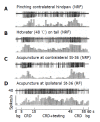Acupuncture inhibition on neuronal activity of spinal dorsal horn induced by noxious colorectal distention in rat
- PMID: 15742405
- PMCID: PMC4250762
- DOI: 10.3748/wjg.v11.i7.1011
Acupuncture inhibition on neuronal activity of spinal dorsal horn induced by noxious colorectal distention in rat
Abstract
Aim: To observe how acupuncture stimulation influences the visceral nociception in rat and to clarify the interactions between acupuncture or somatic input and visceral nociceptive inputs in the spinal dorsal horn. These will provide scientific base for illustrating the mechanism of acupuncture on visceral pain.
Methods: Experiments were performed on Sprague-Dawley rats and the visceral nociceptive stimulus was generated by colorectal distention (CRD). Unit discharges from individual single neuron were recorded extracellularly with glass-microelectrode in L(1-3) spinal dorsal horn. Acupuncture stimulation was applied at contralateral heterotopic acupoint and ipsilateral homotopic acupoint, both of which were innervated by the same segments that innervate also the colorectal-gut.
Results: The visceral nociception could be inhibited at the spinal level by the heterotopic somatic mechanical stimulation and acupuncture. The maximal inhibition was induced by acupuncture or the somatic noxious stimulation at spinal dorsal horn level with inhibiting rate of 68.61% and 60.79%, respectively (P<0.01 and <0.001). In reversible spinalized rats (cervical-thoracic cold block) both spontaneous activity and responses to CRD increased significantly in 16/20 units examined, indicating the existence of tonic descending inhibition. The inhibition of acupuncture on the noxious CRD disappeared totally in the reversible spinalized rats (P<0.001).
Conclusion: The inputs of noxious CRD and acupuncture may interact at the spinal level. The nociceptive visceral inputs could be inhibited by acupuncture applied to hetero-topic acupoint. The effect indicates that the spinal dorsal horn plays a significant role in mediating the inhibition of acupuncture and somatic stimulation on the neuronal response to the noxious visceral stimulation and the inhibition is modulated by upper cervical cord and/or supra-spinal center.
Figures






Similar articles
-
Electrical stimulation of thalamic Nucleus Submedius inhibits responses of spinal dorsal horn neurons to colorectal distension in the rat.Brain Res Bull. 2003 Feb 15;59(6):413-20. doi: 10.1016/s0361-9230(02)00945-0. Brain Res Bull. 2003. PMID: 12576136
-
[Acupuncture inhibiting responses of spinal dorsal dorsal horn neurons induced by noxious dilation rectum and colon].Zhongguo Zhen Jiu. 2005 Sep;25(9):645-50. Zhongguo Zhen Jiu. 2005. PMID: 16318154 Chinese.
-
Ongoing and stimulus-evoked activity of sympathetically correlated neurons in the intermediate zone and dorsal horn of acutely spinalized rats.J Neurophysiol. 2000 May;83(5):2699-707. doi: 10.1152/jn.2000.83.5.2699. J Neurophysiol. 2000. PMID: 10805670
-
The role of the dorsal column pathway in visceral nociception.Curr Pain Headache Rep. 2001 Feb;5(1):20-6. doi: 10.1007/s11916-001-0006-1. Curr Pain Headache Rep. 2001. PMID: 11252134 Review.
-
Neurobiological concepts of fibromyalgia--the possible role of descending spinal tracts.Scand J Rheumatol Suppl. 2000;113:24-9. doi: 10.1080/030097400446599. Scand J Rheumatol Suppl. 2000. PMID: 11028827 Review.
Cited by
-
Acupuncture for visceral pain: neural substrates and potential mechanisms.Evid Based Complement Alternat Med. 2014;2014:609594. doi: 10.1155/2014/609594. Epub 2014 Dec 29. Evid Based Complement Alternat Med. 2014. PMID: 25614752 Free PMC article. Review.
-
Effect of electroacupuncture on visceral hyperalgesia, serotonin and fos expression in an animal model of irritable bowel syndrome.J Neurogastroenterol Motil. 2010 Jul;16(3):306-14. doi: 10.5056/jnm.2010.16.3.306. Epub 2010 Jul 26. J Neurogastroenterol Motil. 2010. PMID: 20680170 Free PMC article.
-
Electroacupuncture Relieves Neuropathic Pain via Adenosine 3 Receptor Activation in the Spinal Cord Dorsal Horn of Mice.Int J Mol Sci. 2024 Sep 24;25(19):10242. doi: 10.3390/ijms251910242. Int J Mol Sci. 2024. PMID: 39408573 Free PMC article.
-
Acupuncture reduces crying in infants with infantile colic: a randomised, controlled, blind clinical study.Acupunct Med. 2010 Dec;28(4):174-9. doi: 10.1136/aim.2010.002394. Epub 2010 Oct 18. Acupunct Med. 2010. PMID: 20959312 Free PMC article. Clinical Trial.
-
Central and Peripheral Mechanism of Acupuncture Analgesia on Visceral Pain: A Systematic Review.Evid Based Complement Alternat Med. 2019 May 2;2019:1304152. doi: 10.1155/2019/1304152. eCollection 2019. Evid Based Complement Alternat Med. 2019. PMID: 31186654 Free PMC article. Review.
References
-
- Mayer EE, Munakata J, Mertz H, Lembo T, Bernstein CN. Visceral hyperalgesia and irritable bowel syndrome. In: Visceral Pain, Progress in Pain and Research Management, edited by Gebhart GF., editors. Seattle: IASP; 1995. pp. 429–467.
-
- Ness TJ, Metcalf AM, Gebhart GF. A psychophysiological study in humans using phasic colonic distension as a noxious visceral stimulus. Pain. 1990;43:377–386. - PubMed
-
- Munakata J, Naliboff B, Harraf F, Kodner A, Lembo T, Chang L, Silverman DH, Mayer EA. Repetitive sigmoid stimulation induces rectal hyperalgesia in patients with irritable bowel syndrome. Gastroenterology. 1997;112:55–63. - PubMed
-
- Ness TJ. Models of Visceral Nociception. ILAR J. 1999;40:119–128. - PubMed
-
- Ness TJ, Gebhart GF. Characterization of neuronal responses to noxious visceral and somatic stimuli in the medial lumbosacral spinal cord of the rat. J Neurophysiol. 1987;57:1867–1892. - PubMed
Publication types
MeSH terms
LinkOut - more resources
Full Text Sources

